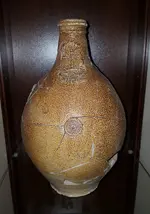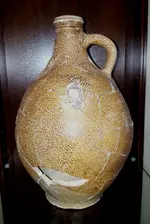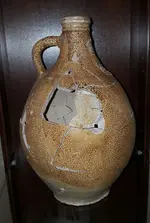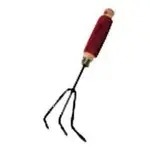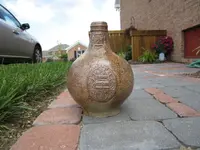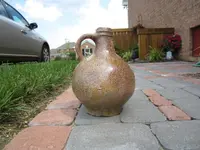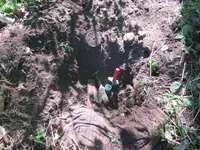DownNDirty
Bronze Member
- Joined
- Jun 1, 2015
- Messages
- 2,178
- Reaction score
- 3,207
- Golden Thread
- 1
- Location
- South Carolina
- 🥇 Banner finds
- 1
- 🏆 Honorable Mentions:
- 1
- Detector(s) used
- Minelab Equinox 800
- Primary Interest:
- All Treasure Hunting
For those of you who read my last post you will remember that I ran into a three-foot gator in a creek on the way to the trash pit I call the Swamp Pit. Well I went back to the pit last Saturday-and the gator (or "Ollie" as I have named him) was nowhere to be found. The creek level dropped so I guess he headed back to the swamp.
The pit had dried out a lot thanks to a lack of rain for several days. What was a pond on Labor Day had improved to this:
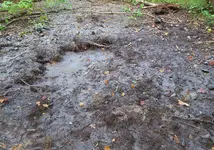
While it was a far cry from the slosh pit that I wallowed in last Monday it didn't take long for me to get covered in mud.
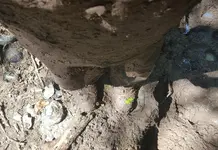
Undeterred I worked my way through more black glass shards, brick fragments and animal bones. My main goal for the day was to find as many of the missing shards to a Bartmann (aka Bellarmine) jug that I was reconstructing. I wasn't disappointed. I found seven of the shards, and one of them has a small medallion stamped into the clay. I was not able to find either of the large medallions that had been applied to the sides but my theory is that the jug owner removed and kept them before discarding the jug. They may have contained a family crest-but that is just a theory and I will never know.
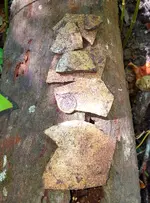
I spent Saturday night and part of Sunday cleaning the shards and gluing them in place. I am really pleased with the result; I would estimate that the jug is about eighty percent complete.
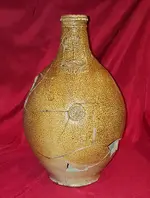
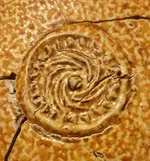
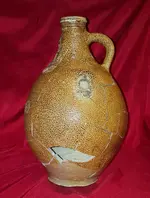
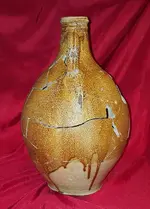
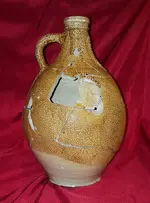
I also found quite a few shards of a plain while bowl with the consistency of china.
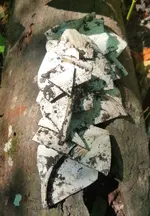
I was hoping that I had enough of it to reconstruct the bowl, and as it turned out that was the case. It's only missing three small pieces.
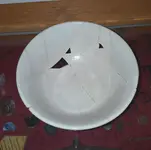
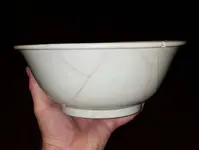
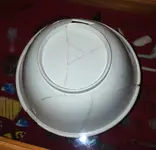
One interesting find was a cow horn. At first I had hoped that it would be a powder horn, but there is no evidence of it being altered for use as such.
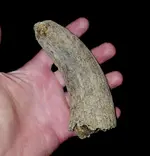
I also found the base to a green rectangular bottle and a large wooden bottle/jug stopper.
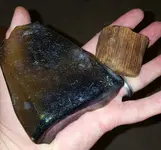
And lastly, I got really excited when I found part of the neck of a second Bellarmine jar. I searched and searched but never found another piece of it, but I believe the rest of it has to be somewhere in the pit.
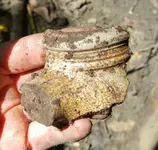
So it was another good day in the Swamp Pit. It just keeps giving up surprises and has not disappointed me yet. Gotta love that mud!
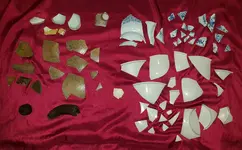
The pit had dried out a lot thanks to a lack of rain for several days. What was a pond on Labor Day had improved to this:

While it was a far cry from the slosh pit that I wallowed in last Monday it didn't take long for me to get covered in mud.

Undeterred I worked my way through more black glass shards, brick fragments and animal bones. My main goal for the day was to find as many of the missing shards to a Bartmann (aka Bellarmine) jug that I was reconstructing. I wasn't disappointed. I found seven of the shards, and one of them has a small medallion stamped into the clay. I was not able to find either of the large medallions that had been applied to the sides but my theory is that the jug owner removed and kept them before discarding the jug. They may have contained a family crest-but that is just a theory and I will never know.

I spent Saturday night and part of Sunday cleaning the shards and gluing them in place. I am really pleased with the result; I would estimate that the jug is about eighty percent complete.





I also found quite a few shards of a plain while bowl with the consistency of china.

I was hoping that I had enough of it to reconstruct the bowl, and as it turned out that was the case. It's only missing three small pieces.



One interesting find was a cow horn. At first I had hoped that it would be a powder horn, but there is no evidence of it being altered for use as such.

I also found the base to a green rectangular bottle and a large wooden bottle/jug stopper.

And lastly, I got really excited when I found part of the neck of a second Bellarmine jar. I searched and searched but never found another piece of it, but I believe the rest of it has to be somewhere in the pit.

So it was another good day in the Swamp Pit. It just keeps giving up surprises and has not disappointed me yet. Gotta love that mud!

Attachments
Last edited:
Upvote
15



